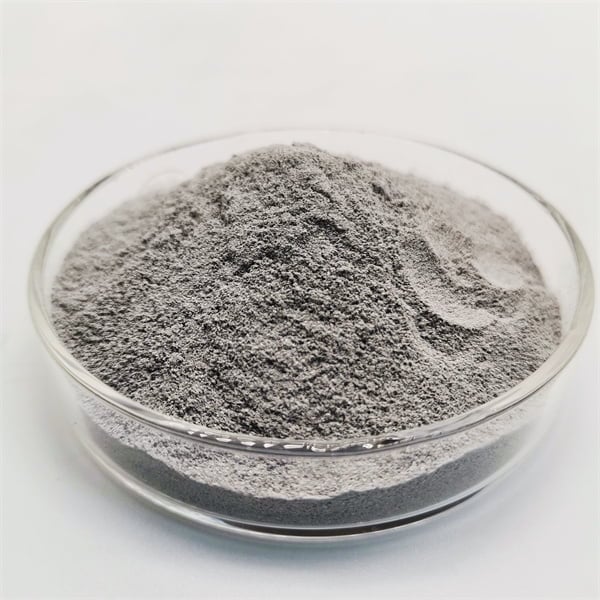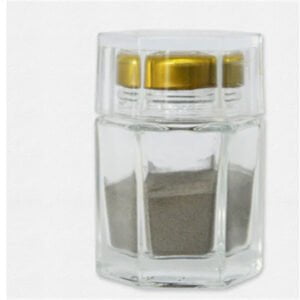Prášek pro aditivní výrobu
Obsah
Přehled
Aditivní výroba (AM), známá také jako 3D tisk, využívá kovové prášky ke konstrukci komponent vrstvu po vrstvě na základě digitálních modelů. Prášek působí jako surovina a je selektivně taven, sintrován nebo vázán přesnými zdroji tepla řízenými geometriemi CAD.
Populární AM procesy pro kovy zahrnují tryskání pojiva, nanášení s řízenou energií, tavení práškového lože a laminování plechů. Každá technika vyžaduje prášek se specifickými vlastnostmi pro dosažení optimální hustoty, povrchové úpravy, rozměrové přesnosti a mechanických vlastností tištěných dílů.
Tato příručka poskytuje hloubkový pohled na kovový prášek pro AM, včetně možností slitin, výrobních metod, klíčových vlastností prášku, aplikací, specifikací, dodavatelů a úvah o nákupu při získávání materiálu. Užitečné srovnávací tabulky shrnují technické údaje, které vám pomohou s výběrem a kvalifikací prášku.
Získávání optimalizovaného AM prášku umožňuje výrobcům zlepšit kvalitu tisku, snížit vady a plně využít výhody 3D tisku, jako je svoboda návrhu, rychlejší iterace a konsolidace součástí. Spojení s informovanými dodavateli zjednodušuje kvalifikaci surovin.

Možnosti slitiny pro AM Powder
K dispozici je široká škála kovů a slitin jako optimalizované práškové suroviny pro procesy 3D tisku:
Společné slitinové systémy pro Prášek pro aditivní výrobu
- Nerezové oceli
- Nástrojové oceli
- Titan a slitiny titanu
- Slitiny hliníku
- Niklové superslitiny
- Kobalt-chromové slitiny
- Drahé kovy jako zlato, stříbro
- Exotické slitiny jako měď, tantal, wolfram
Standardní i zakázkové slitiny lze získat tak, aby splňovaly specifické potřeby, pokud jde o odolnost proti korozi, pevnost, tvrdost, vodivost nebo jiné vlastnosti.
Metody výroby kovového prášku pro AM
Aditivní výroba využívá kovový prášek vyrobený pomocí:
Typické způsoby výroby kovového prášku pro AM
- Rozprašování plynu
- Rozprašování vody
- Plazmová atomizace
- Elektrolýza
- Proces karbonylového železa
- Mechanické legování
- Hydridování/dehydridace kovů
- Sféroidizace plazmy
- Granulace
Sférické atomizované prášky poskytují optimální průtok a husté balení požadované pro většinu AM procesů. Některé techniky umožňují nanoměřítko nebo upravené slitinové částice.
Klíčové vlastnosti AM Metal Powder
Mezi kritické vlastnosti prášku pro AM patří:
Kov Prášek pro aditivní výrobu Vlastnosti
| Charakteristický | Typické hodnoty | Důležitost |
|---|---|---|
| Distribuce velikosti částic | 10 až 45 mikronů | Ovlivňuje zhuštění, povrchovou úpravu |
| Tvar částic | Sférické | Zlepšuje tok prášku a balení |
| Zdánlivá hustota | 2 až 4 g/cc | Ovlivňuje hustotu práškového lože |
| Hustota poklepání | 3 až 6 g/cc | Označuje stlačitelnost |
| Hallův průtok | 25-50 s/50g | Zajišťuje hladké nanášení prášku |
| Ztráta při zapálení | 0.1-0.5% | Nízký obsah vlhkosti zlepšuje tisk |
| Obsah kyslíku | <0.1% | Minimalizuje vady způsobené oxidy |
Přesné řízení charakteristik, jako je velikost částic, tvar a chemie, je rozhodující pro dosažení plně hustých AM dílů s požadovanými vlastnostmi.
Aplikace AM Metal Powder
Aditivní výroba umožňuje složité geometrie nemožné konvenčními technikami:
Aplikace aditivní výroby kovů
| Průmysl | Používá | Výhody |
|---|---|---|
| Aerospace | Lopatky turbín, konstrukce | Volnost designu, snížení hmotnosti |
| Lékařský | Implantáty, protézy, nástroje | Přizpůsobené tvary |
| Automobilový průmysl | Odlehčovací prototypy a nástroje | Rychlá iterace |
| Obrana | Díly dronů, ochranné konstrukce | Rychlé prototypy a krátké série |
| Energie | Výměníky tepla, rozdělovače | Konsolidace dílů a optimalizace topologie |
| Elektronika | Stínění, chladicí zařízení, EMI | Komplexní uzavřené struktury |
Lehkost, konsolidace součástí a vysoce výkonné slitiny pro extrémní prostředí poskytují klíčové výhody oproti tradičním výrobním metodám.
Specifikace pro AM Metal Powder
Mezinárodní specifikace pomáhají standardizovat vlastnosti AM prášku:
Normy kovového prášku pro aditivní výrobu
| Standard | Oblast působnosti | Parametry | Zkušební metody |
|---|---|---|---|
| ASTM F3049 | Průvodce pro charakterizaci kovů AM | Odběr vzorků, analýza velikosti, chemie, defekty | Mikroskopie, difrakce, SEM-EDS |
| ASTM F3001-14 | Titanové slitiny pro AM | Velikost částic, chemie, průtok | Prosévání, SEM-EDS |
| ASTM F3301 | Slitiny niklu pro AM | Analýza tvaru a velikosti částic | Mikroskopie, analýza obrazu |
| ASTM F3056 | Nerezová ocel pro AM | Chemie, vlastnosti prášku | ICP-OES, pyknometrie |
| ISO/ASTM 52921 | Standardní terminologie pro AM prášky | Definice a charakteristiky prášku | Různé |
Shoda s publikovanými specifikacemi zajišťuje opakovatelnou, vysoce kvalitní práškovou surovinu pro kritické aplikace.
Globální dodavatelé AM kovového prášku
Mezi přední mezinárodní dodavatele kovových prášků optimalizovaných pro AM patří:
Výrobci kovového prášku pro aditivní výrobu
| Dodavatel | Materiály | Typická velikost částic |
|---|---|---|
| Sandvik | Nerez, nástrojová ocel, slitiny niklu | 15-45 mikronů |
| Praxair | Titan, superslitiny | 10-45 mikronů |
| AP&C | Slitiny titanu, niklu a kobaltu | 5-25 mikronů |
| Přísada pro tesaře | Kobalt chrom, nerez, měď | 15-45 mikronů |
| Technologie LPW | Slitiny hliníku, titan | 10-100 mikronů |
| EOS | Nástrojová ocel, kobalt chrom, nerez | 20-50 mikronů |
Mnozí se zaměřují na jemné sférické prášky speciálně navržené pro běžné AM metody, jako je tryskání pojiva, fúze práškového lože a řízená depozice energie.
Zvažte nákup AM Metal Powder
Klíčové aspekty, které je třeba projednat s dodavateli:
- Požadované složení a vlastnosti slitiny
- Cílová distribuce velikosti částic a tvar
- Hustota obálky a zatékavost haly
- Povolené úrovně nečistot, jako je kyslík a vlhkost
- Požadované testovací údaje a charakterizace prášku
- Dostupné množství a dodací lhůty
- Zvláštní opatření pro manipulaci se samozápalnými slitinami
- Systémy kvality a sledovatelnost původu prášku
- Technická odbornost v požadavcích na prach AM
- Logistické a dodací mechanismy
Úzce spolupracujte s dodavateli se zkušenostmi s prášky specifickými pro AM, abyste zajistili ideální výběr materiálu pro váš proces a komponenty.
Výhody a nevýhody AM Metal Powder
Výhody vs omezení kovového prášku pro aditivní výrobu
| Výhody | Nevýhody |
|---|---|
| Umožňuje složité, přizpůsobené geometrie | Vyšší náklady než běžné materiály |
| Výrazně zkracuje dobu vývoje | Nutná opatření pro manipulaci s práškem |
| Zjednodušuje montáže a odlehčuje | U vytištěných dílů je často potřeba následné zpracování |
| Dosahuje vlastností blízkých tvářeným materiálům | Omezení velikosti a objemu |
| Eliminuje drahé nástroje | Tepelné namáhání může způsobit praskání a deformaci |
| Umožňuje konsolidaci dílů a optimalizaci topologie | Nižší objemy výroby než tradiční metody |
| Výrazně zlepšuje poměr mezi nákupem a odletem | Vyžaduje přísnou charakterizaci prášku a vývoj parametrů |
Při správném použití poskytuje metal AM výhody, které mění hru, ale k úspěšné implementaci vyžaduje odborné znalosti.

Nejčastější dotazy
Jak malá může být velikost částic pro výrobu kovových přísad?
Specializované atomizační techniky mohou produkovat prášek až do 1-10 mikronů, nicméně většina tiskáren kovů pracuje nejlépe s minimální velikostí kolem 15-20 mikronů pro dobrý průtok a balení.
Co způsobuje špatnou povrchovou úpravu tištěných kovových dílů?
Drsnost povrchu vzniká z částečně roztaveného prášku přilnutého k povrchu, rozstřiku, schodišťového stupně a suboptimálních charakteristik lázně taveniny. Použití jemnějších prášků a vytáčení v ideálních parametrech zpracování vyhlazuje povrch.
Fungují všechny metody 3D tisku na kov se stejnými prášky?
I když dochází k překrývání, tryskání pojiva obecně používá širší distribuci velikosti prášku než fúze práškového lože. Některé procesy jsou omezeny na určité slitiny na základě bodů tání nebo reaktivity.
Jak se vyrábí smíšené nebo bimetalické prášky?
Předlegované prášky zajišťují jednotné vlastnosti, ale pro kompozity poskytuje fyzikální míšení prášků nebo specializované techniky atomizace vlastní smíšené základní práškové směsi.
Jak dlouho trvá výměna práškového materiálu v kovové tiskárně?
Úplné propláchnutí a přechod mezi výrazně odlišnými slitinami obvykle vyžaduje 6-12 hodin. Rychlé změny mezi podobnými materiály mohou trvat méně než hodinu.
Závěr
Optimalizované kovové prášky umožňují aditivní výrobní procesy ke konstrukci složitých, robustních kovových součástí s vynikajícími vlastnostmi. Pro dosažení vysoké kvality výsledků je zásadní sladit chemii slitiny a vlastnosti prášku s tiskovou metodou a požadavky na výkon komponent. Díky partnerství se zkušenými dodavateli prášku využívají koncoví uživatelé odborné znalosti v oblasti výroby prášku i procesů 3D tisku k rychlejšímu a spolehlivějšímu vývoji dílů. Neustálý pokrok v oblasti kovových prášků pomáhá řídit zvýšené zavádění aditivních technik v kritických průmyslových odvětvích.
Sdílet na
MET3DP Technology Co., LTD je předním poskytovatelem řešení aditivní výroby se sídlem v Qingdao v Číně. Naše společnost se specializuje na zařízení pro 3D tisk a vysoce výkonné kovové prášky pro průmyslové aplikace.
Dotaz k získání nejlepší ceny a přizpůsobeného řešení pro vaše podnikání!
Související články

Vysoce výkonné segmenty lopatek trysek: Revoluce v účinnosti turbín díky 3D tisku z kovu
Přečtěte si více "O Met3DP
Nedávná aktualizace
Náš produkt
KONTAKTUJTE NÁS
Nějaké otázky? Pošlete nám zprávu hned teď! Po obdržení vaší zprávy obsloužíme vaši žádost s celým týmem.

Kovové prášky pro 3D tisk a aditivní výrobu
SPOLEČNOST
PRODUKT
kontaktní informace
- Město Qingdao, Shandong, Čína
- [email protected]
- [email protected]
- +86 19116340731












